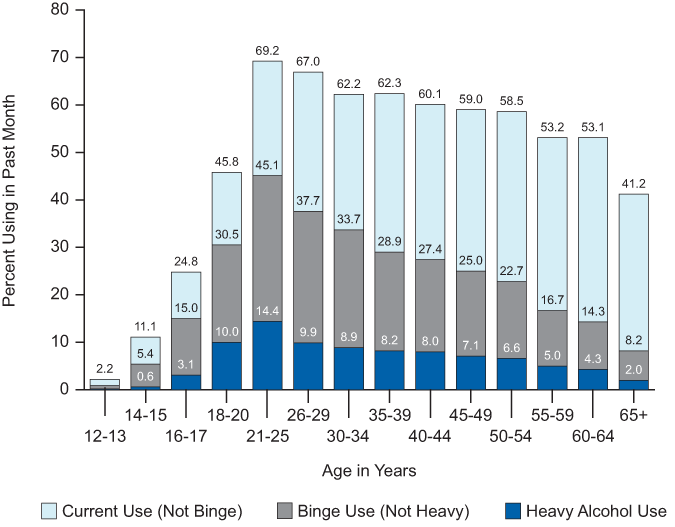To understand Alcohol abuse, we need to understand alcohol use.
Mental Health America characterizes Alcohol use as four drinks per day for men with no more than a total of 14 in one week. For women, appropriate use is three drinks in one day with no more than seven in a one-week period.
A drink is equal to 12 ounces of beer, five ounces of wine, or 1.5 ounces of hard liquor.
These guidelines do not take individual health considerations into account. For example, these guidelines don’t apply to people who are underage or women who are pregnant.
wing diagram is taken from the 2012 National Survey on Drug Use and Health:
This chart illustrates the percentage of individuals surveyed who reported drinking in the last month. Age is represented on the horizontal axis and percentage of those drinking is represented on the vertical axis.
The data is also divided into categories indicating which age group currently drinks alcohol, binge-drinks, and drinks heavily.
General Statistics about Alcohol Abuse in America:
Foundation for a Drug-Free World points to sobering data that emphasizes the concern for alcohol abuse in America:
- Drinking is a popular American pastime. The 2015 National Survey on Drug Use and Health revealed that 86.4 percent of American adults have drunk Alcohol at least once during the course of their lifetime; with 70.1 percent having a drink or more in the past year and 56 percent having a drink or more in the past month.
- Of the 3.9 million Americans who received treatment for a substance abuse problem in 2005, 2.5 million of them were treated for Alcohol abuse.
- Alcohol-related traffic deaths in the U.S. were 12,998 in 2007. This is more than three times as many American soldiers who died in combat in the first six years of the Iraq war.
- There are 1.4 million drunk driving arrests in the US every year.
- A U.S. Department of Justice study found that as many as 40 percent of violent crimes occur under the influence of alcohol.
Alcohol Use in America, by age:
At least 136.7 million people used Alcohol in 2016. The table below breaks this number down into age groups:
- The average age of adolescents having their first taste of alcohol in 2015 was 14.64 years old—the oldest average age since 1999.
- One in 11 adolescents, between the ages of 12 and 17 years old, considered themselves regular drinkers.
- The number of young adults who used Alcohol in 2016 was comparable to that of 2015; however, it has gone down from that in years 2002 through 2014.
- Alcohol use in people aged 26 and older increased from 65 percent to 73 percent, with the highest increases being among women, seniors, minorities and people with low education levels or financial earnings.
An increase in the rate and volume of Alcohol consumed is consistently rising as well as the rate of high-risk drinking in all age groups.
Binge Alcohol Use in America, by age:
In 2005, 16 million people reported that they consider themselves binge-drinkers. In 2016 this number had risen to 65.3 million. Sadly, American Alcohol abuse statistics don’t offer much comfort.
The table below breaks this number down into age groups:
- For every six adults in the United States, one adult binge drinks Alcohol about four times per month at about 8 drinks per bender.
- While binge drinking is reported in all age groups, it’s highest among ages 18-34 years old.
- Men are twice as likely as women to be binge drinkers.
- Over 90 percent of adult binge drinkers report a binge within the last 30 days.
- Binge drinkers under the age of 21 admit to excessive drinking on numerous occasions.
“Alcohol is our number one drug problem, and it’s not just a problem among kids,” says David Jernigan, director of the Center on Alcohol Marketing and Youth at Johns Hopkins Bloomberg School of Public Health.
Alcohol Use in America, by gender:
Women
- About 46 percent of women over the age of 18 noted that they had at least one alcoholic drink in the last 30 days.
- About 12 percent of women over the age of 18 admit to drinking an average of 5 alcoholic drinks on one occasion at least three times per month.
- Approximately 2.5 percent of female drinkers don’t realize that their rate of usage is considered alcohol dependence.
Alcoholism creates a greater susceptibility to some serious health concerns for women. For example, the risk for liver disease attributed to Alcohol consumption is higher for women than it is for men. Women tend to suffer brain shrinkage and memory loss after less time drinking heavily than men do.
Men
- About 58% of men over the age of 18 noted that they had at least one alcoholic drink in the last 30 days.
- About 23% of men over the age of 18 admit to drinking an average of eight alcoholic drinks on one occasion at least five times per month.
- Men are twice as likely to binge drink than women.
Men who drink excessively expose themselves to other types of jeopardy. Men steadily show higher rates of deaths and hospitalizations attributed to Alcohol consumption than women. Men tend to become aggressive while under the influence of Alcohol, which often results in violence or suicide or both.
While this information feels discouraging, it’s important to be aware that Alcohol abuse treatment in America is effective and available. Detox, residential treatment and aftercare are carefully assembled to develop a strategy with each individual’s long-term success at heart.
A life of pride and consistent accomplishments is well within reach and the time to start living it is now. Give us a call today.





















